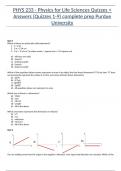PHYS 233 Physics for Life Sciences
Purdue University
All 3 results
Sort by

-
PHYS 233 - Physics for Life Sciences Lab report 4 (Competition Between Brownian Motion and Directed Forces) Purdue University
- Exam (elaborations) • 8 pages • 2024
-
- $11.49
- + learn more
PHYS 233 - Physics for Life Sciences Lab report 4 (Competition Between Brownian Motion and Directed Forces) Purdue University

-
PHYS 233 - Physics for Life Sciences (Lab report Analysis of Brownian Motion) Purdue University
- Exam (elaborations) • 16 pages • 2024
-
- $11.99
- + learn more
PHYS 233 - Physics for Life Sciences (Lab report Analysis of Brownian Motion) Purdue University Abstract In this Lab for PHYS 233, our goal was to determine the diffusion constant for beads of different sizes (1, 2, and 5 microns), different densities (silica versus polystyrene), and different fluid viscosities (water, low glycerol concentration, high glycerol concentration). These beads move in brownian motion which is the random motion of beads. The class results shows that the diffusion con...

-
PHYS 233 - Physics for Life Sciences Quizzes + Answers (Quizzes 1-9) complete prep Purdue University
- Exam (elaborations) • 21 pages • 2024
-
- $12.99
- + learn more
PHYS 233 - Physics for Life Sciences Quizzes + Answers (Quizzes 1-9) complete prep Purdue University Quiz 1 Which of these are physically valid statements? 1. 1 = 2.54 2. 1 in = 2.54 cm 3. 1 in2 = 2.54 cm2 (in other words, 1 square inch = 2.54 square cm) a) All three are valid b) Only #3 c) Only #2 and #3 d) Only #2 e) Only #1 and #2 Which of the equations below cannot represent an area of an object that has linear dimension R? (To be clear “R” does not necessarily repre...

That summary you just bought made someone very happy. Also get paid weekly? Sell your study resources on Stuvia! Discover all about earning on Stuvia


